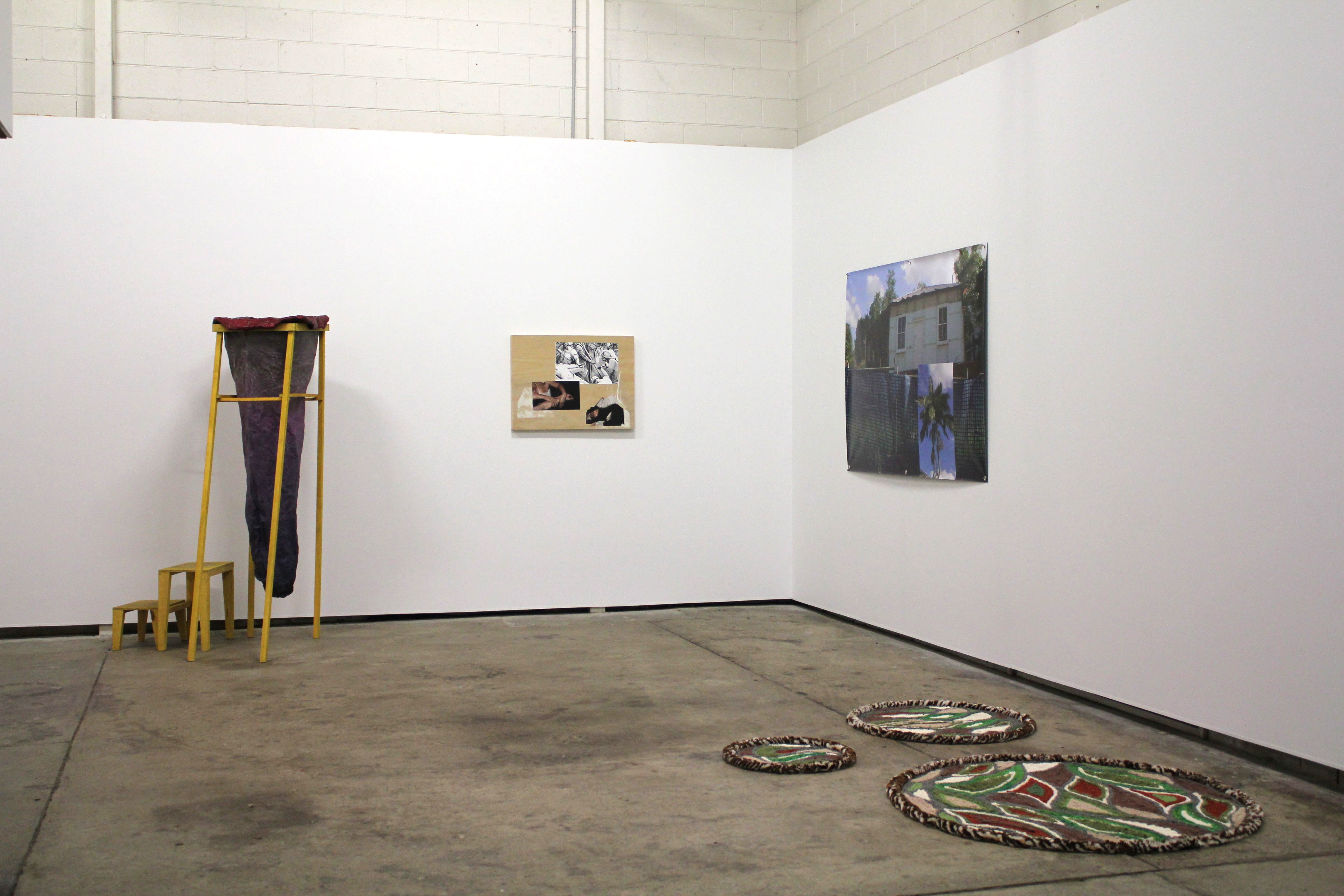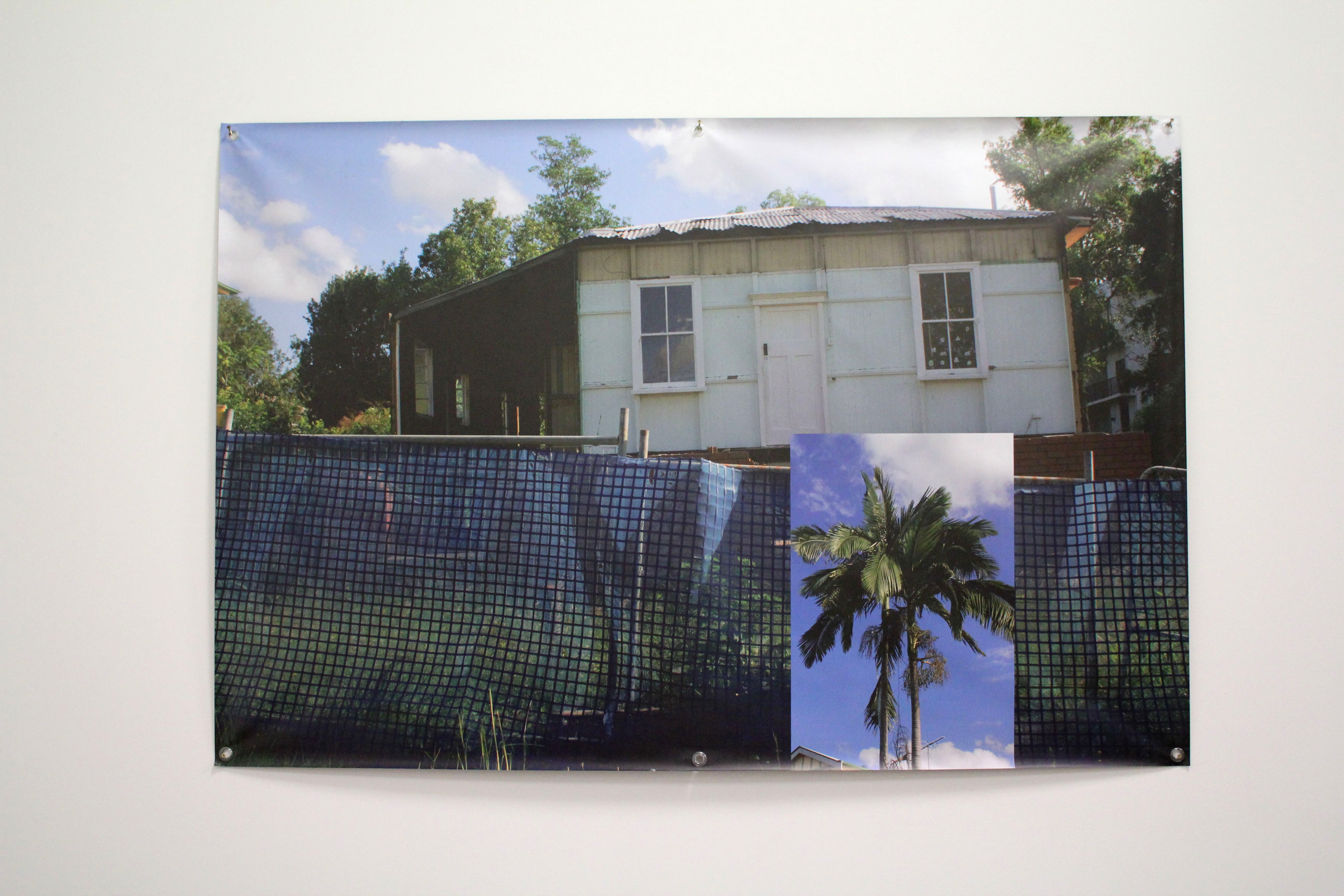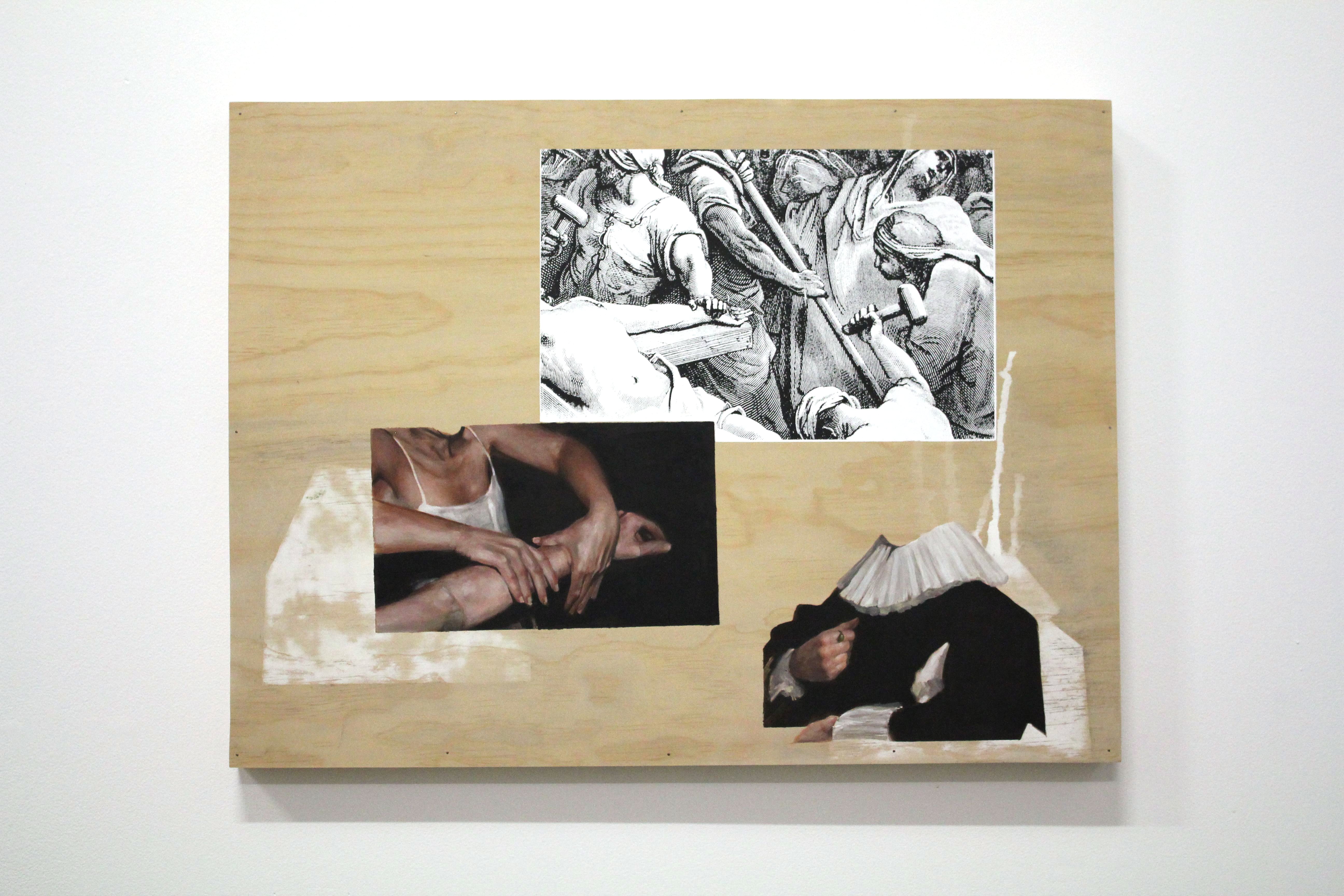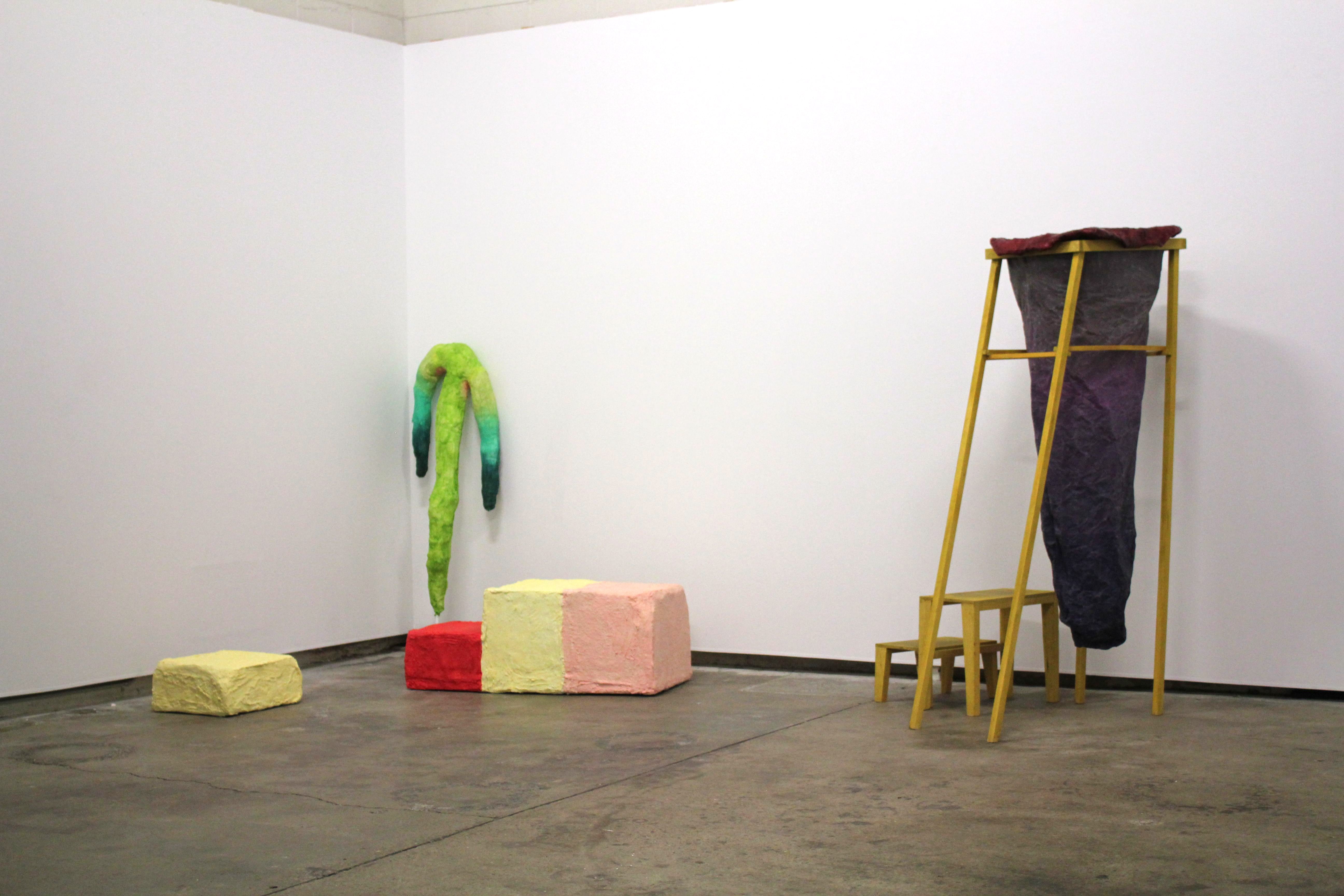




Artists: Chase Archer, Hailey Atkins, Janis Clarke, Ricky Larry, Sophie Penkethman-Young, Melissa Spratt, Veople (Jay Jermyn & Julian Currie).
Curator: Mariam Arcilla
Is it possible to distance yourself from the experiences of place and space when taking in an exhibition? In the city, I rarely think about this. The Gold Coast is a city but not one I inhabit in my mind. Its geography - a long bank of land stretching down the coast - does not feel like the shape of cities I know. THE WALLS ART SPACE, a warehouse in a small industrial estate in Miami, is unique not only in landscape, but in expectation. My friends and I waltz in salty and tousled from the beach, feel comfortable to do so, are welcomed; THE WALLS website states that they can lend you a towel.
PRIZENOPRIZE, in its second annual iteration, is an exhibition curated by Mariam Arcilla from an open-call out for entries. There is no physical prize; the show's intention is to act as a platform for emerging artists and to exist without the seriousness of other art prizes. Arcilla writes that during her selection process she was drawn to works that displayed 'visual trickery'. This is showcased in the way all of the selected works play on physical levels of space both in content and installation; flexibility desired; will travel, down and then up again.
Firmly a winner in losing skin, Hailey Atkin's An unimpressive pit (2017) stands magnetically in the back corner of the gallery. A hand-coloured and waxed fabric cone, shades of amethyst and magenta, a narrow inverse volcano, dangling from a yellow pine frame higher than all heads present. Textured dull but glinting, it reminds me of the one time I dined somewhere with a sommelier; she described a wine as having a ”flinty minerality.” I hold my breath as I climb the two steps to look into the cone to see a roughly textured plastered grey tub, the shape and half the depth of a sink; thought ”oh.” A full stop to the upside down monument of this crystal-glazed daggy majesty. My friend says: "you could christen a baby in there.” We laugh and are renewed. Mum's spag bog (arms are heavy) (2017), a bright green stalk crowned with a gradient green arch-hump, fair-skin coloured armpits, throws me into thinking about how bodies remain erect but slump at the same time, how a standing body can hold craters of shame, about my violent comparison of my body to my mother's. Losers can be winners too (2017), two pastel-and-plaster covered blocks on the floor, makes me think of rainbow Paddle Pops, which make me think of childhood. I learnt recently that rainbow ice cream, always my favourite, indescribable and special, so I thought, is simply caramel flavour. The disappointment continues, ice cream melts, we laugh self-deprecatingly.
The show is united by visual textures dragging us into a space, or outer space. On the floor rests Melissa Spratt's work Ventures (2017), three woven dials of handmade yarn in earthy tones reminiscent of grey oceans and islands in a storm, as well as the shapes bodies can make, edges soft and hard, not touching, but close, curled, resting in dirt.
Ricky Larry's printed banner, The Sprawl Mirror Displacements (2017), brings the illusory into known environments. A photograph of a condemned house fenced off by iconic blue mesh and Cylone fencing evokes the emptiness of walking around suburban streets in the heat. Don't most inner-city suburbs in Australia still feel suburban? Space stretched out. Imposed on top of the photograph is another photograph of a palm tree, blues and greens complimenting, place over place. The palm tree, as seen in Miami, almost stands for modern development. What is natural and what is real? The Gold Coast is one of the only places in Australia where development is allowed right on the beachfront. Palm trees planted here echo the dream of Venice - beach not biennale - concrete and exhaust fumes; would we really want to live there? People really want to live here, and do, and this gallery is a reminder that, like LA, a city that exists in the collective imagination, a place is not as it seems when you don't know it. And you can never know it from something as presumptuous as a drive through, a dip in.
Every work in the show makes a circle, and the expanded paintings of both Chase Archer and Janis Clarke interrogate the relevance of their mediums to contemporary art. Archer's work, Chinese Burn Appreciation Society (2017), uses oil painting and collaged material on plywood, drips of paint linking the art historical and iPhone images to their critique. Clarke's oil painted Bananas (2017) hang like fingers on one side of an MDF sheet; the other side rough-hewn patches of shades of white paint; the whole not quite held in a timber frame of maple and pine running diagonally around the painting, with angles of wall in between. I'm not put off by the abject; I'm drawn in. I want some sugar; I want some potassium after too much sun.
On the mezzanine is Sophie Penkethman-Young's single channel video installation, _HTMLFlatpack (2016). It lords physically over the exhibition based on geography, yet remains secreted away up a lofty wooden staircase. The six-minute work reminds me of my lack of focus, of how time can start out still but whip by via an endless scroll. In four acts we see pools of colour jump and switch on an unlabelled map of the world, inventing new borders, until the borders as we know them are established and an animated finger pokes Europe and turns the screen to static. While watching I think about colonisation, but while writing I think about the game of matching coloured squares that I play on my iPhone. The next section, '200 Clips', whips by faster than an ad for the cinema at the cinema. We see Whoopi Goldberg in Sister Act, Prince Charles being crowned, an orchid bloom, a ship in a storm, and hundreds of images that don't stick, or perhaps they do, to emerge in dreams to be forgotten upon waking. Cultural objects - marble statues, roses, skulls, tigers - are tipped from a hand painted with a gold glove to tumble down through storm clouds to the bottom of the ocean, sunk under a ray of sun that hits the floor of fallen treasure. The work ends with '25 Pieces of Static', then the word 'fin'. Exit cinema, back down, and outside into Saturday afternoon with a storm approaching.
Precarity reigns over the emerging artist in Australia; prize money is hard to come by. Rainbow Paddle Pops are a little more affordable, and after a recent union campaign to boycott Streets ice cream ended in time for summer, the workers invited the public to enjoy the delights. Let us lick in support.
Felicity Scarce is an artist and writer.
